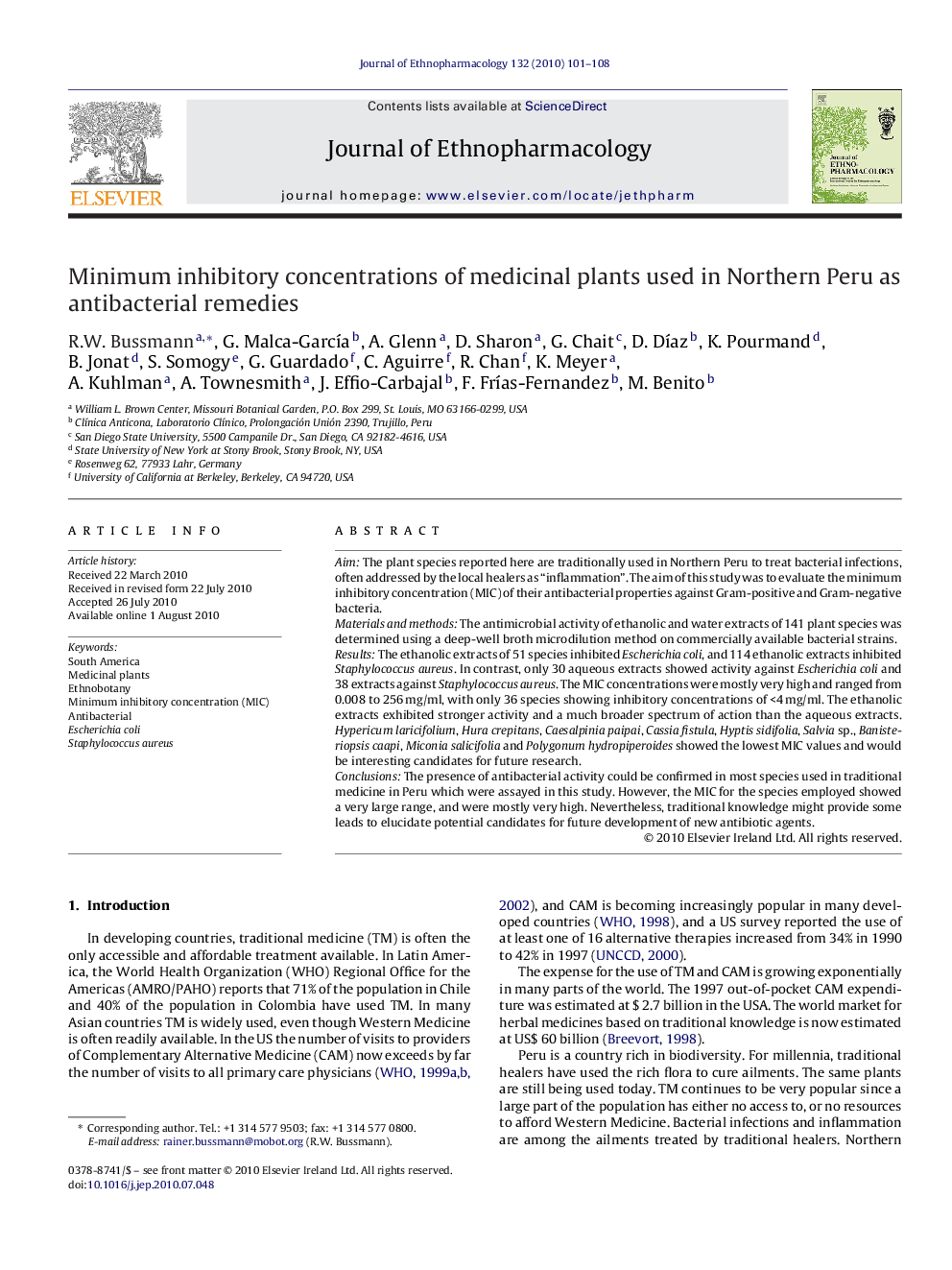| کد مقاله | کد نشریه | سال انتشار | مقاله انگلیسی | نسخه تمام متن |
|---|---|---|---|---|
| 2545653 | 1123990 | 2010 | 8 صفحه PDF | دانلود رایگان |

AimThe plant species reported here are traditionally used in Northern Peru to treat bacterial infections, often addressed by the local healers as “inflammation”. The aim of this study was to evaluate the minimum inhibitory concentration (MIC) of their antibacterial properties against Gram-positive and Gram-negative bacteria.Materials and methodsThe antimicrobial activity of ethanolic and water extracts of 141 plant species was determined using a deep-well broth microdilution method on commercially available bacterial strains.ResultsThe ethanolic extracts of 51 species inhibited Escherichia coli, and 114 ethanolic extracts inhibited Staphylococcus aureus. In contrast, only 30 aqueous extracts showed activity against Escherichia coli and 38 extracts against Staphylococcus aureus. The MIC concentrations were mostly very high and ranged from 0.008 to 256 mg/ml, with only 36 species showing inhibitory concentrations of <4 mg/ml. The ethanolic extracts exhibited stronger activity and a much broader spectrum of action than the aqueous extracts. Hypericum laricifolium, Hura crepitans, Caesalpinia paipai, Cassia fistula, Hyptis sidifolia, Salvia sp., Banisteriopsis caapi, Miconia salicifolia and Polygonum hydropiperoides showed the lowest MIC values and would be interesting candidates for future research.ConclusionsThe presence of antibacterial activity could be confirmed in most species used in traditional medicine in Peru which were assayed in this study. However, the MIC for the species employed showed a very large range, and were mostly very high. Nevertheless, traditional knowledge might provide some leads to elucidate potential candidates for future development of new antibiotic agents.
Objectives: The aim of this study was to evaluate the minimum inhibitory concentration (MIC) of their antibacterial properties against Gram-positive and Gram-negative bacteria. Methods: The antimicrobial activity of ethanolic and aqueous extracts of 141 plant species was determined using a deep-well broth microdilution method on commercially available bacterial strains. Results: The ethanolic extracts of 51 species inhibited Escherichia coli, and 114 ethanolic extracts inhibited Staphylococcus aureus. In contrast, only 30 aqueous extracts showed activity against Escherichia coli and 38 extracts against Staphylococcus aureus. The MIC concentrations ranged from 0.008 to 256 mg/ml. Conclusions: The presence of antibacterial activity could be confirmed in medicinal plants used Peru for the treatment of bacterial infections. The MIC for most species employed showed a large range. Traditional knowledge provides leads to elucidate candidates for future antibiotic agent development. Study area: Peruvian Departments of Amazonas, Piura, Lambayeque, La Libertad, Cajamarca, San Martin, and the Ecuadorian Province of Loja.Figure optionsDownload as PowerPoint slide
Journal: Journal of Ethnopharmacology - Volume 132, Issue 1, 28 October 2010, Pages 101–108